U.S. Review
Labor Market Dodges Summer Slowdown
- Flat June readings for real spending and headline PCE inflation capped a ho-hum first half for the consumer and price growth.
- Both of the ISM surveys pulled back in July, with a particularly sharp slowdown in the non-manufacturing index. Despite the softer numbers, the indices remain at a level consistent with economic growth of 2.0-2.5 percent.
- The labor market exhibited continued strength in this morning’s employment report. Nonfarm payrolls rose by 209,000 in July, the unemployment rate dropped a tick and wage growth improved over the month.
Labor Market Dodges Summer Slowdown
Personal income and spending kicked off the week with a somewhat underwhelming print. Personal income was flat in July despite expectations for a 0.4 percent gain. The headline miss masked a quirk in the details, however, as much of the decline was due to a sharp fall in farm income. Wages and salaries increased a solid 0.4 percent. Real spending rose 0.1 percent on the month and at a 2.6 percent annualized rate in all of Q2, an acceleration from the 1.9 percent pace registered in Q1. Soft price growth in Q2 helped boost the inflation-adjusted numbers. In nominal dollars, the three-month annualized rate was just 3.1 percent in June, the lowest since March 2016. Headline and core inflation, as measured by the PCE deflator, are now half a percentage point below the Fed’s target (top chart).
The total value of construction put-in-place unexpectedly fell to a seasonally adjusted annual rate of $1,205.8 billion in June. Private construction spending registered its third straight monthly decline, and public spending also tumbled in June, slipping 5.4 percent. Rising construction labor and material costs may be creating some headwinds in the industry. The producer price index (PPI) showed nonresidential input prices increasing 2.3 percent in June, and the three-month annualized rate was up a robust 13.2 percent, suggesting more upward momentum in input prices.
The ISM indices signaled a somewhat slower pace of growth in July than they had in recent months. On the manufacturing side, the pullback was modest, as the index slowed 1.5 points from June’s level. Of the 18 manufacturing industries, 15 reported growth, and the survey respondents’ comments were generally upbeat. Looking through the month-to-month volatility, our outlook for the factory sector has largely remained unchanged: slow but steady improvement in industrial production compared to last year.
On the services side, the slowing in the ISM index was a more precipitous 3.5 point drop t0 53.9. The decline was broad-based, with the steepest drop coming from the forward-looking new orders index. Respondent comments were mixed, with some purchasing managers citing a summer slowdown that they expect to fade in the coming months. On a three-month moving average basis, both indices are hovering just above 56, a level consistent with the 2.0-2.5 percent growth we have penciled in for the second half of the year (middle chart).
Employers added 209,000 net new jobs in July, above the consensus expectation for a 180,000 gain. The details of the report were just as strong as the headline number suggests. Manufacturers added a solid 16,000 new jobs, and education & health and professional & business services remained the drivers of job growth. Average hourly earnings rose 0.3 percent over the month and 2.5 percent over the year. In addition, the labor force participation rate rose a tick to 62.9 percent while the unemployment rate fell an equal amount. If wages accelerate a bit more in the coming months, the Fed will be well positioned to resume hiking the fed funds rate in December.
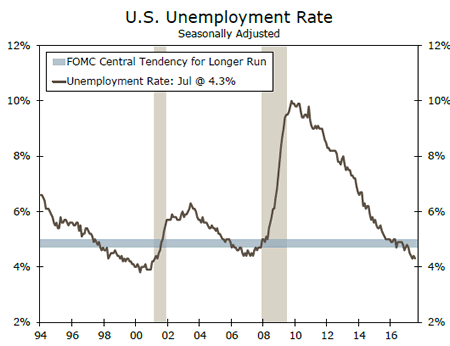

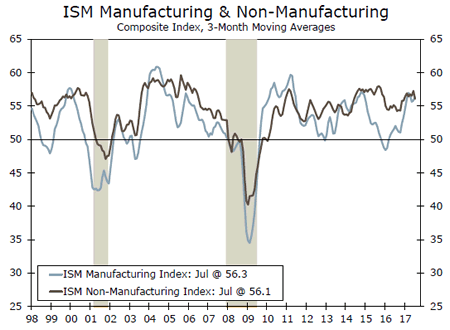

U.S. Outlook
Consumer Credit • Monday
Consumer credit rose $18.4 billion in May which was the largest increase seen so far in 2017. Revolving credit, which includes credit cards, led the acceleration in May, while the increase in nonrevolving loans, which mostly consists of motor vehicle and education loans, held steady. Interest rates also continued to drift higher in May for credit card and auto loans.
Consumer credit as a share of disposable income held steady at 26.5 percent in May, as disposable income rose 0.4 percent that month. Disposable personal income was flat in June, however, which suggests that measure could jump if credit continues to rise. Spending was also soft in June, which raises the possibility that consumer credit growth also may have slowed, although it would not take much of an increase to push the ratio of credit to income to an all-time high.
Previous: $18.4B Consensus: $16.0B
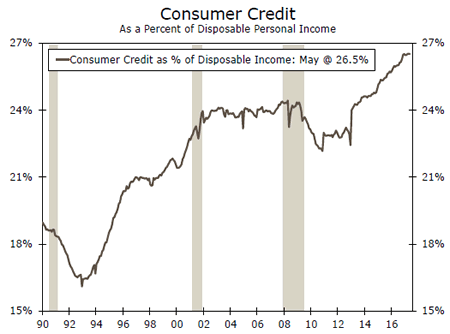
JOLTS • Tuesday
Details underlying June’s strong job gain of 231,000 jobs should shed some light on the outlook for stronger wage gains in coming months. The JOLTS report in May showed a large increase in hiring while the number of openings fell; while that runs slightly counter to the softer jobs report in May, it is useful to note that hiring and openings in the JOLTS report are measured at the last day of the month. The faster pace of hiring was picked up in the June jobs report.
There was also a large increase in the number of quits in May, which may translate into stronger wage gains if sustained in coming months. Wage growth has been stubbornly subdued this year considering how low the unemployment rate has fallen. As more experienced workers quit their jobs for new opportunities, it should put upward pressure on wages.
Previous: 5666K

Consumer Price Index • Friday
Consumer prices were flat in June, extending the soft patch for inflation indicators. The consumer price data have shown that consumers paid less on a range of products and services in recent months, from home furnishings to cell phone plans. Lower gasoline prices have also been a boon to consumer wallets. However, the extra spending power appears to have had little effect on consumption decisions. Personal spending growth slowed in Q2 relative to Q1, and was flat on an inflation-adjusted basis in June.
Headline and core CPI are slipping farther from the Fed’s 2 percent year-over-year growth target. Inflation and wages have put the Fed in a tough position, and the continued miss on price growth indicators caused us to push back our call for the third rate hike this year to December.
Previous: 0.0% Wells Fargo: 0.2% Consensus: 0.2% (Month-over-Month)

Global Review
Solid Global Growth in Q2
- The year-over-year rate of real GDP growth in the Eurozone rose to a six-year high of 2.1 percent in Q2, while Mexico posted another solid quarter of growth on a sequential basis. It appears that the Japanese economy also had a good quarter in Q2.
Q3 Looks to Be Off to a Good Start in Many Economies
- Recent indicators suggest that the German economy entered Q3 with a fair amount of momentum, while PMIs in the United Kingdom and China remained well above the demarcation line separating expansion from contraction in July.
Solid Global Growth in Q2
There was more evidence this week that global economic growth was solid in Q2. For starters, real GDP in the Eurozone grew at an annualized rate of 0.6 percent in Q2, which lifted the year-overyear growth rate to a six-year high of 2.1 percent (see chart on front page). In Mexico, real GDP jumped 0.6 percent (not annualized) in Q2, which followed the 0.7 percent gain registered in Q1.
We will not have Q2 GDP data from Japan until Aug. 14, but industrial production (IP) rose 1.6 percent in June relative to the previous month. Looking at Q2 in its entirety, IP grew at an annualized rate of 7.7 percent on a sequential basis. The strong IP data (top chart) give us more confidence that our projection of 1.7 percent annualized growth in Japanese GDP in Q2 is realistic.
Q3 Looks to Be Off to a Good Start in Many Economies
There are not many data releases from Q3 yet, but the data that we do have suggest that Q3 has gotten off to a good start in many foreign economies. In Germany, retail sales rose 1.1 percent on a sequential basis in June, which follows on the heels of the 0.5 percent gain registered during May. Although these data points are from Q2, they indicate that retail spending came into Q3 with a fair amount of momentum. Factory orders rose 0.8 percent in Q2 relative to Q1, pointing to strong growth in manufacturing production in Q3.
If the purchasing managers’ indices are a good indication, then the British economy also got off to a decent start in Q3. The manufacturing PMI rose to 55.1 in July from 54.2 in June, while the service sector PMI edged up to 53.8 (middle chart). Despite the continued solid readings in the PMIs, the Monetary Policy Committee (MPC) at the Bank of England kept its main policy rate unchanged at 0.25 percent, where it has been maintained since last August. The decision was widely expected.
Real GDP in the United Kingdom was up only 1.7 percent on a year-ago basis in Q2 2017, and the MPC said that it expects growth will remain "sluggish in the near term as the squeeze on households’ real incomes continues to weigh on consumption." Although the MPC expects that inflation will remain above its 2 percent target for the foreseeable future, the MPC appears to have a relaxed attitude to the overshoot. Most members of the MPC reason that a rate hike now would lead to even slower economic growth. As we detailed in our recent report, we expect that the MPC will keep policy unchanged until well into 2018. (See "U.K. Mid-Year Economic Outlook", which is posted on our website.)
Real GDP in China was up 6.9 percent on a year-ago basis in Q2, and the PMIs for July suggest that growth remains solid in the current quarter. The Caixin manufacturing PMI rose to 51.1 (bottom chart). Although the "official" PMI edged down last month, it generally remains well within expansion territory. See "China Mid-Year Economic Outlook" for more details on our China forecast through the end of 2018.
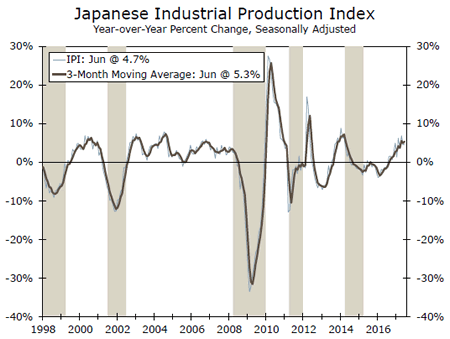
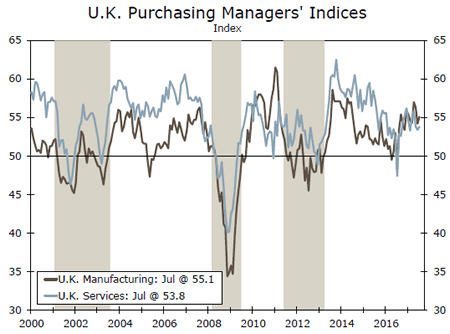
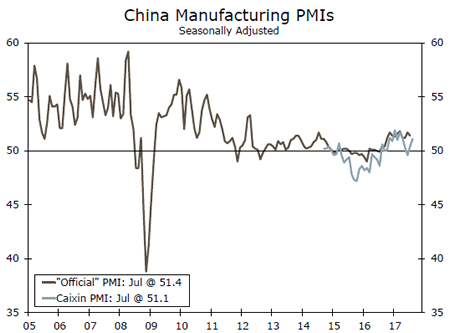
Global Outlook
Germany Industrial Production • Monday
After hitting a series’ high of 59.6 in June of this year, Germany’s Markit/BME Manufacturing PMI slowed down marginally in July, to 58.1, and reversed a seven-month upward trend for the index. However, the index remained strong and continued to point to a relatively strong German economy.
On Monday, markets will have an opportunity to validate the strength in industrial production reflected by the already released PMI index for June when the industrial production index for June is released.
On docket for release on Tuesday will be the trade and current account balances for June. Clearly, one of the reasons for the improved economy has been an improved export market for German production so the international trade numbers will also help validate the improvement in economic activity.
Previous: 1.2% Consensus: 0.2% (Month-over-Month)
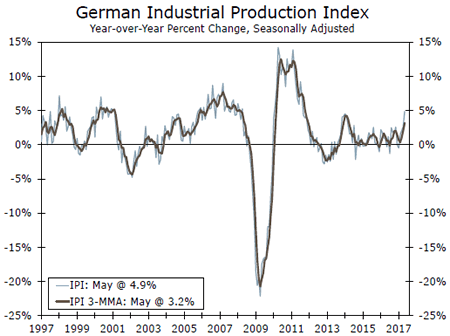
U.K. Industrial Production • Thursday
The U.K. economy has weakened a bit recently even though we are not expecting a downturn any time soon (See "U.K. Mid-Year Economic Outlook", which is available on our website). On Thursday, we will take a look at the industrial production index which declined 0.1 percent in May and consensus is expecting to come in flat for June. On a year-earlier basis the index dropped 0.2 percent in May and the expectation is for the index to continue its decline at a rate of 0.1 percent. Meanwhile, consensus expects manufacturing production to rise 0.1 percent in June, compared to a decline in May by 0.1 percent. On a year-earlier basis however, consensus expects the manufacturing industry to have slightly improved to 0.6 percent in June from a growth rate of 0.4 percent in May.
We will also get the NIESR monthly GDP proxy for July on Thursday. The index increased 0.3 percent in June after a 0.2 percent print in May.
Previous: -0.1% Consensus: 0.1% (Month-over-Month)

Mexico Industrial Production • Friday
Mexican economic growth has surprised this year as some of the worse predictions regarding U.S. policy changes toward Mexico have not materialized. However, growth remains subpar for the growth needs of the country.
On Friday, markets will have a chance to take a look at industrial and manufacturing production for June, perhaps the first month in 2017 that we could say that the number will be devoid of any important "calendar" factor.
What markets will be looking for is an improvement in manufacturing production of automobiles, which has been lagging the rest of the manufacturing and industrial sector. This will also be a good indicator of the direction of automobile demand north of the border, which has eyebrows rising lately in the U.S. consumer market.
Previous: 1.0% (Year-over-Year)

Point of View
Interest Rate Watch
Inflation Dynamics at the Micro Level.
The pattern in this economic expansion is one of lower unemployment rates from 2010 to late 2015 and yet the inflation rate slowed over that same period. Only in the last year has inflation, the CPI, risen while the unemployment rate continued to decline and yet the pace of inflation remains modestly below the FOMC’s 2 percent target. The traditional thinking about a tradeoff hypothesis of these two series has not played out. Why?
An Alternative Model
Our approach is to follow the path of micro foundations of the inflation process. In this case, inflation drives wage negotiations, or more precisely, changes in inflation are the driver for changes in wages. In addition, wages must reflect the value of the marginal product of workers—that is, this value depends upon the marginal product of the worker and the value of the output as measured by the price of that output.
Wages have tracked the path of inflation and productivity since 1982. This pattern reflects the underlying micro foundation that wages track the combination of productivity and inflation gains. A firm cannot pay their workers a salary in excess of their productivity and the value (price) of the output they produce. Public discussion often starts by arguing for higher wages but there is little discussion of the underlying drivers of inflation and productivity.
An Alternative View of Monetary Policy
For investors, the challenge is that interest rate expectations based upon Fed policy take into account a policy expectation that a lower unemployment rate will generate higher inflation. To date, the rise in inflation is less than what would be expected based upon a traditional model of the inflation process and thereby the extent of the increase in interest rates remains above what would be the result of our alternative model. Our alternative approach continues to indicate interest rate increases on the low side of consensus and that has been the right forecast for the past four years.



Credit Market Insights
Auto Loan Market in Distress?
The rate of new seriously delinquent auto loans has climbed for 13 consecutive quarters and reached 2.3 percent in Q1. The rate of these new seriously delinquent loans is still below its recession peak of 3.5 percent. The total value of the loans stands at $8.3 billion, just below the recession peak.
Low rates and an improving economy since 2008 fueled a vehicle sales boom, financed with increasingly more debt. Furthermore, rising auto prices, stagnant real incomes and yield-hungry investors contributed to loan quality deterioration. The average auto loan maturity climbed sharply to 67.4 months in May from 59.5 months in 2009. In addition, outstanding subprime loan balances have ballooned to an all-time high of $280 billion, and the pronounced worsening in subprime loan performance has been responsible for much of the overall rise in auto loan delinquencies.
How much of a threat is the auto loan market to households and to the broader financial system? Auto loans are only 9.2 percent of household debt, and pale in comparison to the size and level of securitization of the mortgage market, the origin of the last financial crisis.
Furthermore, the July Senior Loan Officer Opinion Survey reported a fall in auto loan demand and an increase in the percentage of banks tightening standards for auto loans. As the economic recovery continues to grind along, the auto loan market is certainly worth monitoring.
Topic of the Week
Three Hurdles to 3 Percent Growth
President Trump’s 2018 budget assumes uninterrupted increases in the pace of economic growth during each of the next three years before real GDP growth levels out at 3 percent for every year thereafter. Our own forecast is less sanguine, as are those of the Congressional Budget Office and the Blue Chip consensus (top chart).
While it is true that real GDP growth has averaged 3.2 percent per year since 1950, that average is skewed by much higher growth rates in the early part of that period. For more than a generation, 3 percent real GDP growth has been much tougher to achieve on a sustained basis. Since 1970, average annual GDP growth has been 2.7 percent. Since 2000, it is just 1.9 percent.
The economy’s long-run sustainable rate of economic growth is driven by three factors: labor, capital and total factor productivity (TFP). Relying on just one of these inputs to achieve 3 percent growth over the next decade would require unrealistically rosy assumptions. For example, reaching three percent potential growth through labor alone would require potential labor hours growth in the neighborhood of the rates achieved during the period when mass inflows into the labor force occurred from baby boomers and women.
Getting all three inputs moving in the right direction at once is challenging, but the bottom chart illustrates what it might look like by comparing current projections with the most recent decade over which potential growth averaged 3 percent. As the chart shows, replicating the 1997-2007 period would be a difficult task, as this past period included a major technological revolution and boomers in their prime working years.
None of this is to say that the economy could never grow at such a strong pace again, but history has shown that all three of these factors tend to change at a slow pace, which suggests long lead times before new policies could achieve the fleeting objective of 3 percent growth.














